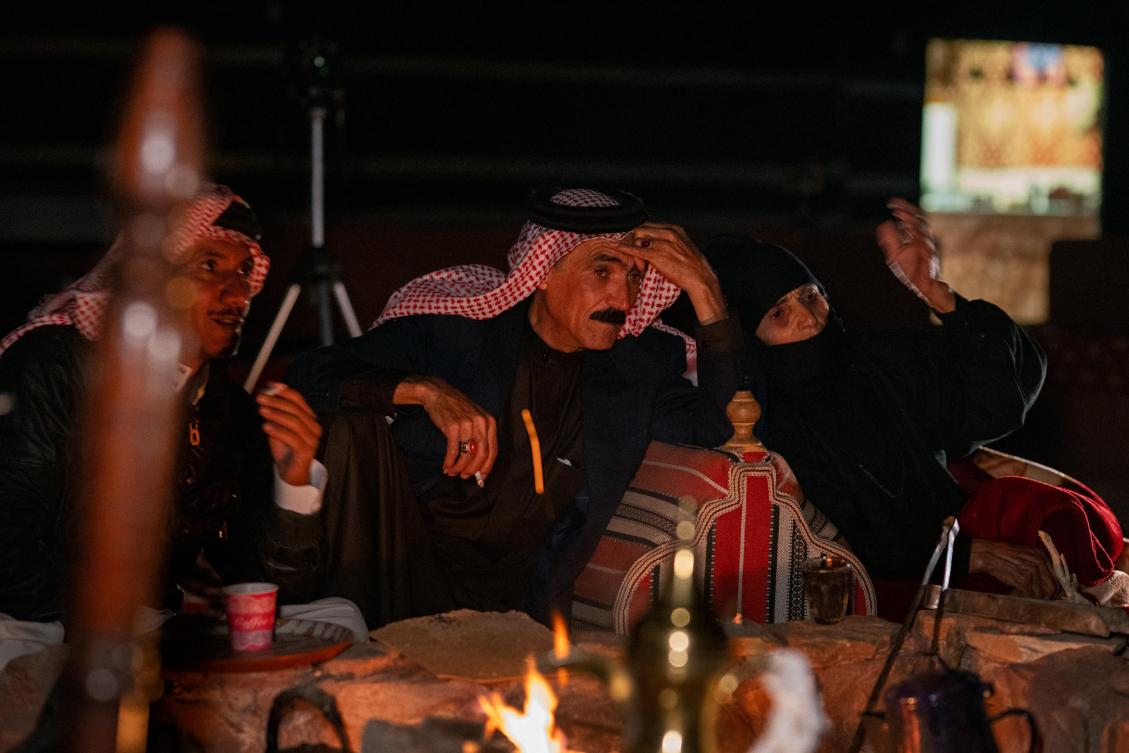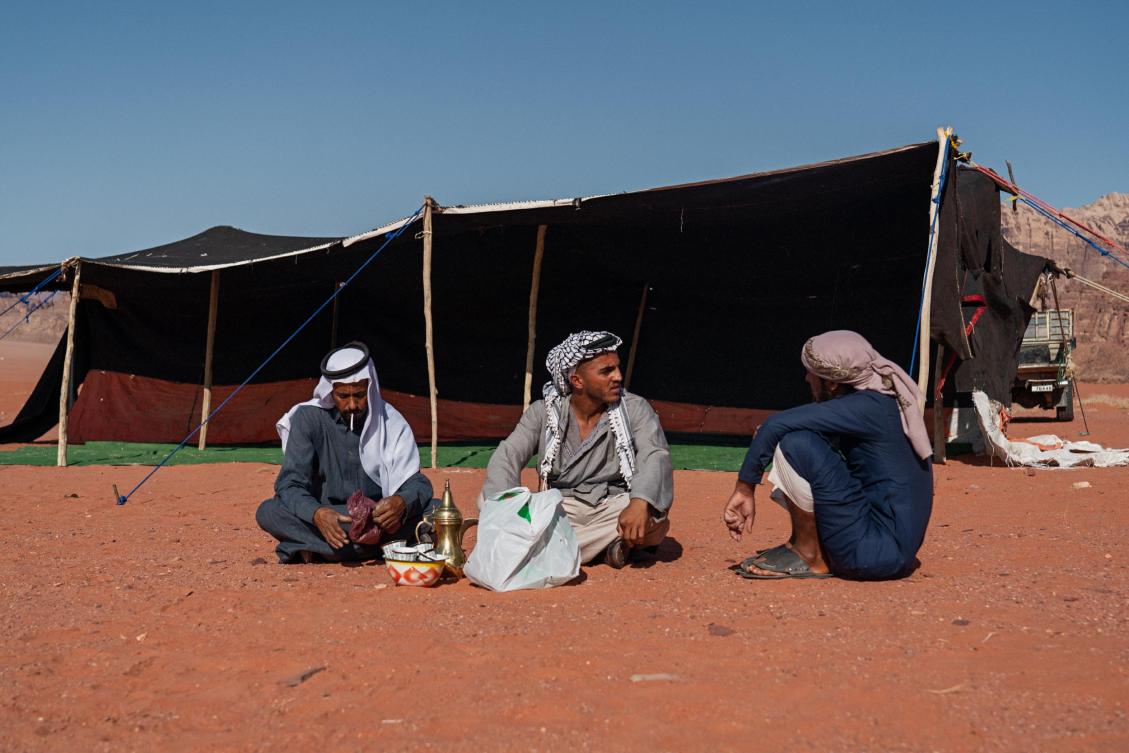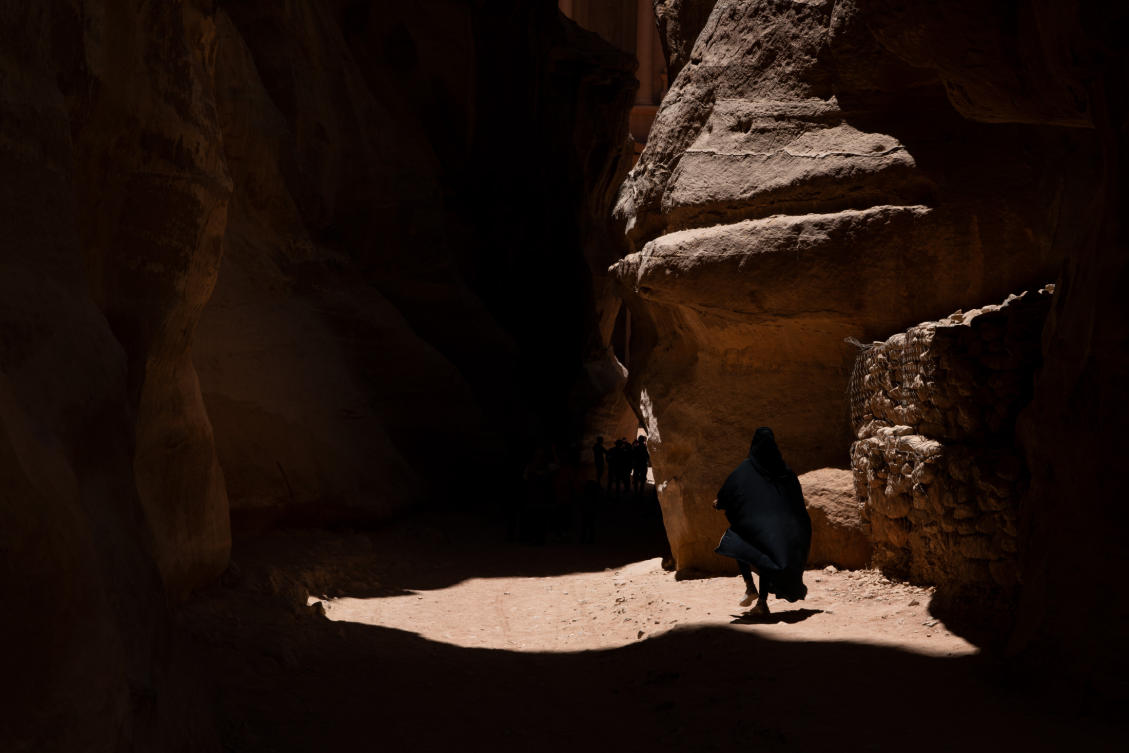LONDON: An exhibition celebrating the cultural heritage of the Bedouin people living in Lebanon, Jordan and the Occupied Palestinian Territories opens in London on Wednesday.
“Arab Bedouin: No Future Without Past” gives visitors a chance to meet members of the Bedouin community living in the Levant, learn their stories told through art, photography, film and audio, and gain an understanding of the challenges they face and their hopes for the future.
The free exhibition, which is open from 11 a.m. to 6 p.m., Jan. 15 to 25 at Oxo Tower Wharf in London’s South Bank , is an initiative of the Cultural Corridors of Peace project, which aims to safeguard Bedouin cultural heritage in the 21st century.
It presents the Bedouin way of life as it is now and highlights the “contradiction between the past and the present,” said Aphrodite Sorotou, project director of Cultural Corridors of Peace.

Gathering of Bedouin in Jordan. (Photo: Stamos Abatis for CCP
“Bedouins had a nomadic way of life in the past, when they roamed the desert freely, but now they have been forced to settle in really poor conditions — there is a contradiction between the two. We are trying to put an emphasis on that and see how we can help these people have a voice and presence.”
Bedouins were traditionally “semi-nomadic people moving in the desert, either in the Syrian steppe, the Arabian Peninsula or other parts of the Middle East where there was desert,” Sorotou added. “They mainly practiced pastoralism and had camels, sheep and goats, and they are identified by a very traditional way of life that dictates the way they function as a society.”
A Bedouin lineage, being able to pass on the story of one’s forefathers, having a link to previous generations, and identifying with a tribe were also requirements, she said.
However, balancing modernization with tradition is a challenge faced by the Bedouins of today. Most have settled and no longer practice their nomadic and tribal traditions. Their livelihood has changed and, in some cases, their cultural heritage has disappeared.
“There are not many Bedouins left that fit the traditional way of life,” said Carol Palmer, Cultural Corridors of Peace’s project coordinator for Jordan. “Only a minority now live in tents, live off their animals and move around, because modern life has created other opportunities; there have been strong pressures to sedentarize. There have also been many government initiatives in the past to build housing and send children to school.
“Most Bedouins are now living in settlements or villages and go to work. Often, they mix professions, and they may have some animals and also have a business or go to work, and so they earn a living from a number of opportunities,” Palmer added.
Sorotou said some Bedouins in Jordan have managed to preserve aspects of their cultural heritage by using their traditional identity to attract tourists and earn money from this. In doing so, however, they “slightly diminish the genuine character of the heritage,” she added.
“In places like Wadi Rum and Petra, you see Bedouins trying to approach you and sell you things such as a camel ride or a handmade item,” Sorotou said. “In reality, they have lost contact with their own dialect or they present what tourists expect to see: a romanticized version of their life.
“The reality is different. These people have been living in very harsh environments for centuries and have managed to find ways to live in the desert; now they are being forced to live in a completely different way. I understand that they are trying to survive in any way possible, and if tourism is an option, then of course they will take it.”

Resting after setting up a Bedouin tent for the Regional Gathering in Jordan. (Photo: Stamos Abatis for CCP)
The main challenges the Bedouin face are political and economic, she explained. They do not have any significant political representation in the countries where they have settled, with the exception of Jordan. This raises a number of issues, including a lack of a voice or influence in society, and economic marginalization to the point where they are just surviving. Some might have slightly more money than others but are unable to do much with it.
As part of the Cultural Corridors of Peace project, a regional gathering was held in Jordan in October so that Bedouin communities from Jordan, Lebanon and the Occupied Palestinian Territories could connect with each other and discuss their shared culture.
The meeting was proposed by Lebanese Bedouins, who wanted to connect with others from neighboring countries. There are about 300,000 Bedouins in Lebanon. A large proportion live along the Bekaa valley, where their cultural heritage is at risk as a result of socioeconomic circumstances and restrictions of movement across the border with Syria.
“We observed that the Bedouin communities have a need to remain connected to one another,” said Sorotou. “They feel much more connected to each other than they do to non-Bedouin citizens around them.”
The Bedouin communities from different countries almost instantly connected with each other at the gathering in Jordan, she said, and “it was apparent from their body language that they felt very comfortable with each other and were ready to share anecdotes as if they were family. I have not seen people make such a connection with each other in such a short period of time before, and that happened within a few hours.”

Bedouin woman in Petra, Jordan. (Photo: Stamos Abatis for CCP)
The Bedouins celebrated their shared heritage through a variety of activities such as tent erecting, the preparation of traditional food and coffee, craft making, music and songs, stories and poems, and exploring the use of natural resources to survive in the desert. Topics such as hospitality, identity, customary law and the role of women and men in Bedouin societies were also discussed.
Sorotou said events such as the exhibition in London and the gathering in Jordan will help young Bedouins move toward a more modern way of life while also recognizing the value of their heritage and cultural identity.
“If we work with them now and make them feel proud of their identity, there is a chance that they will start caring about it and preserving it themselves,” she said. “As part of the Cultural Corridors of Peace project, we have trained a lot of young Bedouins in methods of documentation and presentation of cultural heritage.”
Although lasting change for the better will require another generation and acceptance from the wider societies around them, Sorotou believes that if given financial opportunities, Bedouins in Lebanon, Jordan and the occupied Palestinian Territories would “perform miracles.” They are trying to balance the demands of modernization with their traditional cultural heritage, something that they did not have to do previously, she said.
“They are trying not to make the mistakes that other cultures have made in the past,” Sorotou added. “That’s the main message that we want to give through the exhibition. That’s where the next phase of the project will go, and we will try to identify methods and strategies to keep their traditions and cultural heritage alive without depriving young people of the opportunity to flourish.”
































